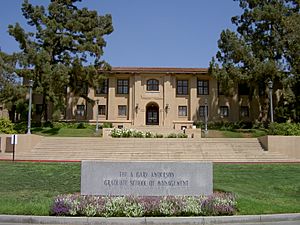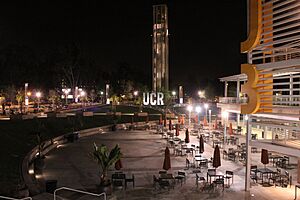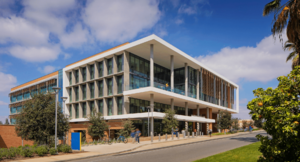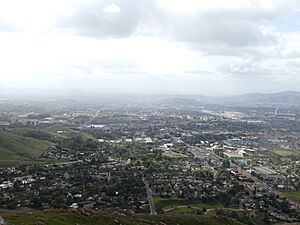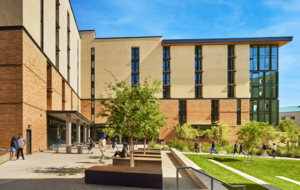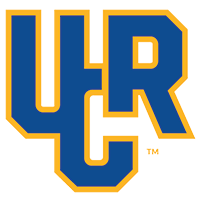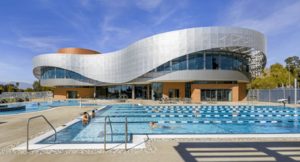University of California, Riverside facts for kids
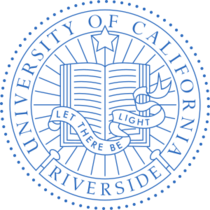 |
|
| Motto | Fiat lux (Latin) |
|---|---|
|
Motto in English
|
"Let there be light" |
| Type | Public land-grant research university |
| Established | February 14, 1954 |
|
Parent institution
|
University of California |
| Accreditation | WSCUC |
|
Academic affiliation
|
|
| Endowment | $249.87 million (2023) |
| Budget | $1.3 billion (2023) |
| Chancellor | S. Jack Hu |
| Provost | Elizabeth Watkins |
|
Academic staff
|
1,638 |
|
Administrative staff
|
1,938 |
| Students | 26,809 (2022) |
| Undergraduates | 22,903 (2022) |
| Postgraduates | 3,906 (2022) |
| Location |
,
,
United States
|
| Campus | Large city, 2,131 acres (862 ha) |
| Other campuses | Palm Desert |
| Newspaper | The Highlander |
| Colors | Blue and gold |
| Nickname | Highlanders |
|
Sporting affiliations
|
|
| Mascot | Scotty Highlander |
 |
|
The University of California, Riverside (UCR or UC Riverside) is a large public university in Riverside, California. It is one of ten campuses in the University of California system. UCR is known as a research university, meaning its professors and students do a lot of important scientific and academic studies.
The main campus is about 1,900 acres (769 ha) in Riverside. There is also a smaller campus in Palm Desert. UCR started in 1907 as the UC Citrus Experiment Station. This station studied how to grow citrus fruits better and how to control pests.
UCR welcomed its first college students in 1954. By 1959, it became a full university campus. Graduate students, who are studying for advanced degrees, started attending in 1961. The university has grown a lot, with many new buildings added since 1999. In 2013, UCR opened a new medical school, the first new public medical school in California in 40 years. UCR is a member of the Association of American Universities, a group of leading research universities.
UCR's sports teams are called the Highlanders. They play in NCAA Division I, which is the highest level of college sports. Their nickname comes from the campus's location on the foothills of Box Springs Mountain.
Contents
A Look Back: UCR's History
In the early 1900s, Southern California was famous for growing citrus fruits. To help this industry, the UC Citrus Experiment Station (CES) was started in Riverside on February 14, 1907. It began on 23 acres (9 ha) of land. The station studied how to fertilize plants, irrigate fields, and improve crops. In 1917, it moved to a larger 475 acres (192 ha) site near Box Springs Mountain.
After World War II, many soldiers returned home and wanted to go to college. This led to a big increase in college students. Local leaders and citrus growers wanted a new college in Riverside. In 1949, a bill was signed to create a new campus, with $2 million for construction.
Gordon Samuel Watkins became the first leader of the new college in Riverside. He wanted it to be a small college focused on liberal arts, which are subjects like history, literature, and art. The college opened on February 14, 1954, with 65 teachers and 127 students.
By 1958, UCR had over 1,000 students. The University of California system decided to make Riverside a full university campus in 1959. Herman Theodore Spieth became UCR's first chancellor. He helped the school grow to hold up to 5,000 students. Later, Chancellor Ivan Hinderaker guided the campus through student protests, keeping them peaceful.
In the 1990s, UCR was chosen for fast growth. The goal was to have 19,900 students by 2010. By 1995, UCR had the highest percentage of African American, American Indian, and Latino students among all UC campuses. This made UCR a very diverse university.
In recent years, UCR has continued to grow. A medical school and a school of public policy opened in 2012. In 2006, UCR received a large gift of $15.5 million to help build its medical school. The medical school officially opened in 2013.
Exploring the Campus
UCR's main campus is located near Box Springs Mountain. It is about 1,112 acres (450 ha) in size. The campus is divided into eastern and western areas by a freeway.
The East Campus has most of the main academic buildings. The first buildings, including the Citrus Experiment Station, were built by 1917. They were designed in the Mission Revival style, which looks like old Spanish missions.
More buildings were added in the 1950s, including the Rivera Library and several halls. After UCR became a general university campus in 1958, many new buildings were constructed. These included student dorms and sports facilities. The Bell Tower, which has 48 bells, was also built during this time. It is 161 ft (49 m) tall.
After a period of slower growth, UCR expanded again in the 1990s. New buildings included Bourns Hall, the Humanities & Social Science building, and the Science Library. New dorms like Pentland and Stonehaven were also built. Many new construction projects have taken place since 1999.

The West Campus has about 511 acres (207 ha) of land. It includes buildings like University Extension and student housing. There is also University Village, which has a movie theater, stores, and restaurants. Some parts of the West Campus are still citrus groves and fields, planned for future growth.
UCR also has a special area downtown called UCR ARTSblock. It includes the UCR/California Museum of Photography, The Sweeney Art Gallery, and the Culver Center of the Arts. These places show art and host events.
Palm Desert Graduate Center
UCR has a graduate center in Palm Desert. It opened in 2001 and focuses on business and entrepreneurship. It also helps with research in areas like conservation and Native American studies. Students can earn master's degrees in business and creative writing here.
What Students Learn: Academics
UCR is part of the University of California system. It is led by a chancellor, currently S. Jack Hu. The university's academic rules are set by its Academic Senate, which is made up of all UCR professors.
UCR has three main colleges and several professional and graduate schools.
- The College of Humanities, Arts and Social Sciences started in 1954.
- The College of Natural and Agricultural Sciences began in 1958.
- The Bourns College of Engineering was founded in 1989.
UCR offers many different study programs. Students can choose from 81 majors and 52 minors for their bachelor's degrees. There are also 48 master's degree programs and 42 PhD programs. UCR is special because it offers undergraduate degrees in creative writing and public policy. It also has a medical degree program with UCLA.
University Rankings
UCR is recognized for its quality. U.S. News & World Report has ranked UCR as the top university in the nation for "social mobility" for several years in a row. This means UCR is very good at helping students from lower-income families succeed and graduate.
In the 2025 U.S. News & World Report rankings, UCR was tied for 76th among all national universities. It was also ranked 36th among public universities. These rankings look at things like how many students graduate, how many resources the university has, and how well professors are rated.
Washington Monthly ranked UCR 79th among national universities in 2024. This ranking considers how well schools help low-income students, how much research they do, and how much they encourage students to serve their community.
Many UCR professors are highly respected. Since 1997, over 110 UCR faculty members have been chosen as fellows of the American Association for the Advancement of Science. Several faculty members have also won Guggenheim Fellowships. UCR currently has two Nobel Prize winners on its faculty.
Research and Discoveries
UCR has a budget of about $1.3 billion. A lot of this money goes into research. In 2018, UCR spent $167.8 million on research projects. A big part of this research is in agricultural science, especially related to citrus.
UCR researchers have created more than 40 new types of citrus fruits. They have also found new ways to fight pests and diseases that affect the citrus industry. For example, in 1927, scientists brought two types of wasps from Australia to control a harmful bug called the citrophilus mealybug. This saved citrus growers a lot of money.
In 1963, a scientist named Charles Coggins found a way to keep fruit on citrus trees longer using a special plant hormone. This helped extend the citrus growing season in California. UCR has also developed new citrus varieties like the Oroblanco grapefruit and the Gold Nugget mandarin.
UCR works with the City and County of Riverside to help people develop new products and businesses. It also manages six natural reserves for research. UCR has partnered with China Agricultural University to study environmental issues in China.
Becoming a Student: Admissions
U.S. News & World Report says that admission to UC Riverside is "more selective." This means it's a competitive school to get into.
For Fall 2018, UCR received almost 50,000 applications from high school students. About half of them were admitted. The average GPA (grade point average) for students who enrolled was 3.83.
UCR is known for its diverse student body. In 2006, almost half of the admitted students were the first in their families to go to college. Many students also came from lower-income backgrounds. In 2007, U.S. News ranked UCR as one of the most ethnically and economically diverse universities in the nation. This means UCR is a great place for students from all backgrounds to get a college education.
Libraries and Special Collections
UCR's libraries have over 2 million books and many electronic journals. The two main libraries are the Tomás Rivera Library and the Raymond L. Orbach Science Library.
The Rivera Library was built in 1954. It holds collections in humanities and social sciences. It also has special collections, including the world's largest collection of science fiction, horror, and fantasy literature, called the Eaton Collection. This library also has the only U.S. Patent and Trademark Depository on a UC campus.
The Raymond L. Orbach Science Library was built in 1998. It has books and resources for science, agriculture, engineering, and computer science.
UCR also has several unique museum collections. The UCR Citrus Variety Collection has 1,800 trees, representing 640 different types of citrus. It's the largest collection of its kind in the world. The UCR Herbarium has over 110,000 dried plant specimens. UCR is also home to 40 acres (16 ha) of botanical gardens with over 3,500 plant species from around the world. You can explore over four miles of trails in these gardens.
The Entomology Research Museum has more than four million insect specimens. The UCR/California Museum of Photography and Sweeney Art Gallery hold UCR's main art collections. The photography museum has a huge collection of old stereographs and photographic equipment. The Sweeney Art Gallery has about 650 unique artworks, including pieces by famous artists.
Life as a UCR Student
| Race and ethnicity | Total | ||
|---|---|---|---|
| Hispanic | 40.0% |
|
|
| Asian | 35.9% |
|
|
| White | 10.3% |
|
|
| Two or more races | 5.0% |
|
|
| Black | 3.5% |
|
|
| International | 3.4% |
|
|
| Unknown | 1.5% |
|
|
| Native American | 0.1% |
|
|
| Native Hawaiian/Pacific Islander | 0.1% |
|
|
| Economic diversity | |||
| Affluent | 52% |
|
|
| Low-income | 48% |
|
|
UCR has a very diverse student body. It has the highest percentage of African American students among all UC campuses. It also has the second highest percentage of Latino students. This makes UCR a popular choice for students from many different backgrounds.
UCR was a leader in supporting LGBT students. It opened a resource center for lesbian, gay, bisexual, and transgender students in 1993. It was also the first UC campus to offer a minor studies program in LGBT topics in 1996.
Student Housing

UCR has four main residence halls: Aberdeen-Inverness, Dundee, Lothian, and Pentland Hills. These dorms can house over 3,000 students. There are also on-campus apartments like Stonehaven and Glen Mor. About half of UCR students live in off-campus apartments.
To support its diverse students, UCR has special "theme halls" in its dorms. For example, there are halls for Latino/Chicano students, African culture, and a gender-neutral community. There are also halls for students in specific academic fields, honor students, and transfer students.
In 2020, a new residence hall and dining facility called Dundee-Glasgow opened. It includes UCR's first two-story restaurant for students.
Clubs and Activities
UCR has over 500 student organizations! The Associated Students of the University of California, Riverside (ASUCR) represents undergraduate students. It helps make decisions about campus policies and manages funds for student groups.
There are 40 fraternities and sororities at UCR. These are social organizations that students can join. About 13% of undergraduate students are part of Greek life. Many student groups also do volunteer work in the community.
Student media includes The Highlander newspaper, which is published every Tuesday. It has been around since 1954. UCR also has a radio station, KUCR at 88.3 FM, which plays independent music and news.
The Associated Students Program Board (ASPB) plans fun events on campus. These include concerts, movies, lectures, and cultural events. Some big events are the Block Party Concert and Spring Splash.
Graduate students also have their own organization, the Graduate Student Association (GSAUCR). It helps fund research and travel for graduate students.
Highlander Sports
UCR's sports teams, the Highlanders, compete in NCAA Division I. They play in the Big West Conference. Sports include soccer, basketball, baseball, softball, tennis, golf, and track and field.
In 1998, students voted to help fund the athletic programs. This allowed UCR to move from NCAA Division II to Division I in 2000. When UCR was in Division II, its teams won 5 national championships in men's baseball and women's volleyball.
The women's basketball team has played in the Division I tournament several times. In 2008, they even beat a highly ranked team, the Vanderbilt Commodores. In 2007, the baseball team won their first Big West championship.
Football was played at UCR until 1975. The team won two championships before the sport was stopped.
Home games for volleyball and basketball are played in the Student Recreation Center Arena. The baseball team plays at the Riverside Sports Complex. A former UCR player, Troy Percival, helped build the baseball clubhouse to professional standards.
UCR also has many student sports clubs. These include a Rugby Football Club and a Karate program. There's also a Men's and Women's Club Soccer team. UCR has a boxing club called Highlander Gloves, which has produced national champions.
The "Highlanders" nickname was chosen in 1954 by UCR's first class of students. It reflects the campus's high location. The mascot is a bear named Scotty Highlander. UCR also has a bagpipe band made up of students and staff. They play at graduation and other events. The blue and gold tartan (a Scottish pattern) worn by the band is a registered trademark of the university.
National Championship Teams (Division II)
- Baseball (1977 and 1982)
- Women's Volleyball (1977 – AIAW, 1982 and 1986)
- Women's Soccer (1983) – first place in the California Collegiate Women's Soccer Conference
Famous People from UCR
Alumni: Graduates of UCR
Over 94,000 people have graduated from UCR. The Alumni and Visitors Center, built in 2007, is a place for graduates to gather.
Some notable alumni include:
- Steve Breen – a cartoonist who won the Pulitzer Prize twice.
- Billy Collins – a famous author and former U.S. Poet Laureate.
- Joe Kelly – a professional baseball player.
- Brenda Martinez – an Olympic runner who competed in the 2016 Rio de Janeiro Olympics.
- Richard R. Schrock – a physicist who won the Nobel Prize in Chemistry.
- Tim D. White – a paleoanthropologist known for his work with "Lucy," one of the oldest known human ancestors.
- Charles E. Young – UCR's first student body president, who later became chancellor of UCLA.
Faculty: Teachers and Researchers at UCR
Many talented people teach and do research at UCR.
- Chris Abani – an author and member of the American Academy of Arts and Sciences.
- Barry Barish – a physicist who won the Nobel Prize in Physics.
- Mike Davis – a historian and recipient of the MacArthur Fellows Program award.
- Nalo Hopkinson – an author who won the World Fantasy Award.
- Sonja Lyubomirsky – a psychologist and author of The How of Happiness.
- Richard R. Schrock – a chemist who won the Nobel Prize in Chemistry.
- Jane Smiley – an author who won the Pulitzer Prize.
- Susan Straight – an author and recipient of the MacArthur Fellows Program award.
|
See also
 In Spanish: Universidad de California en Riverside para niños
In Spanish: Universidad de California en Riverside para niños



